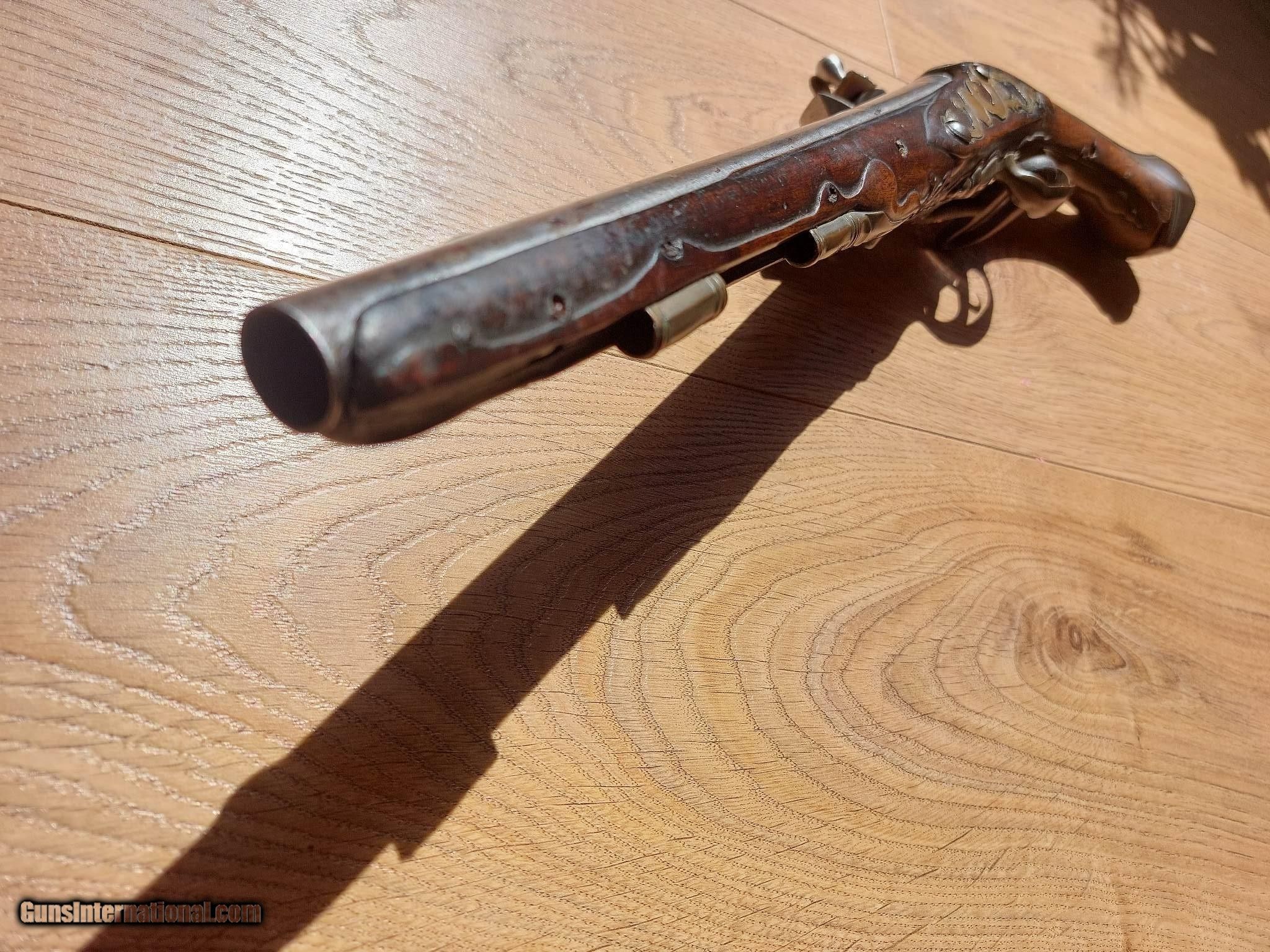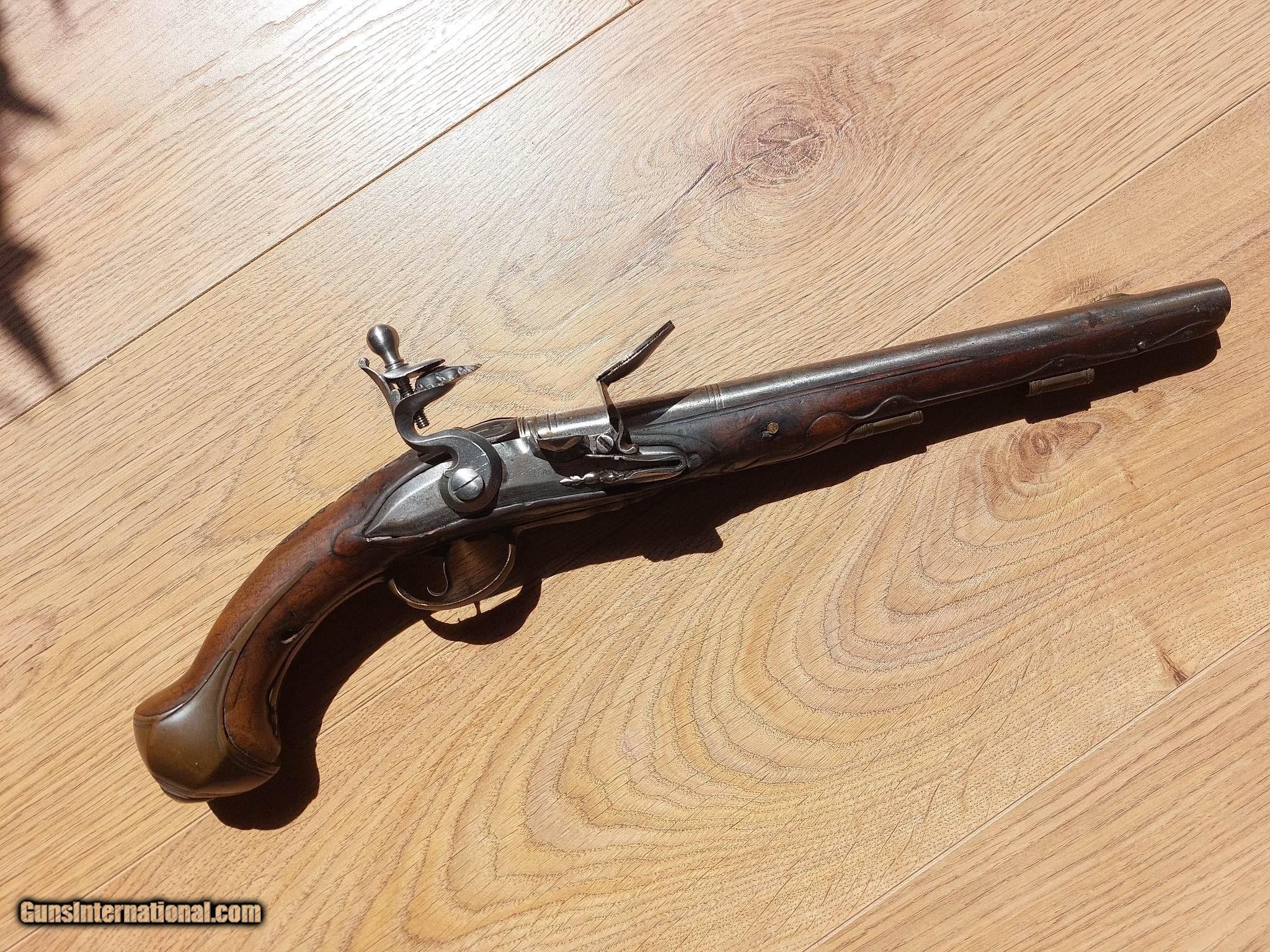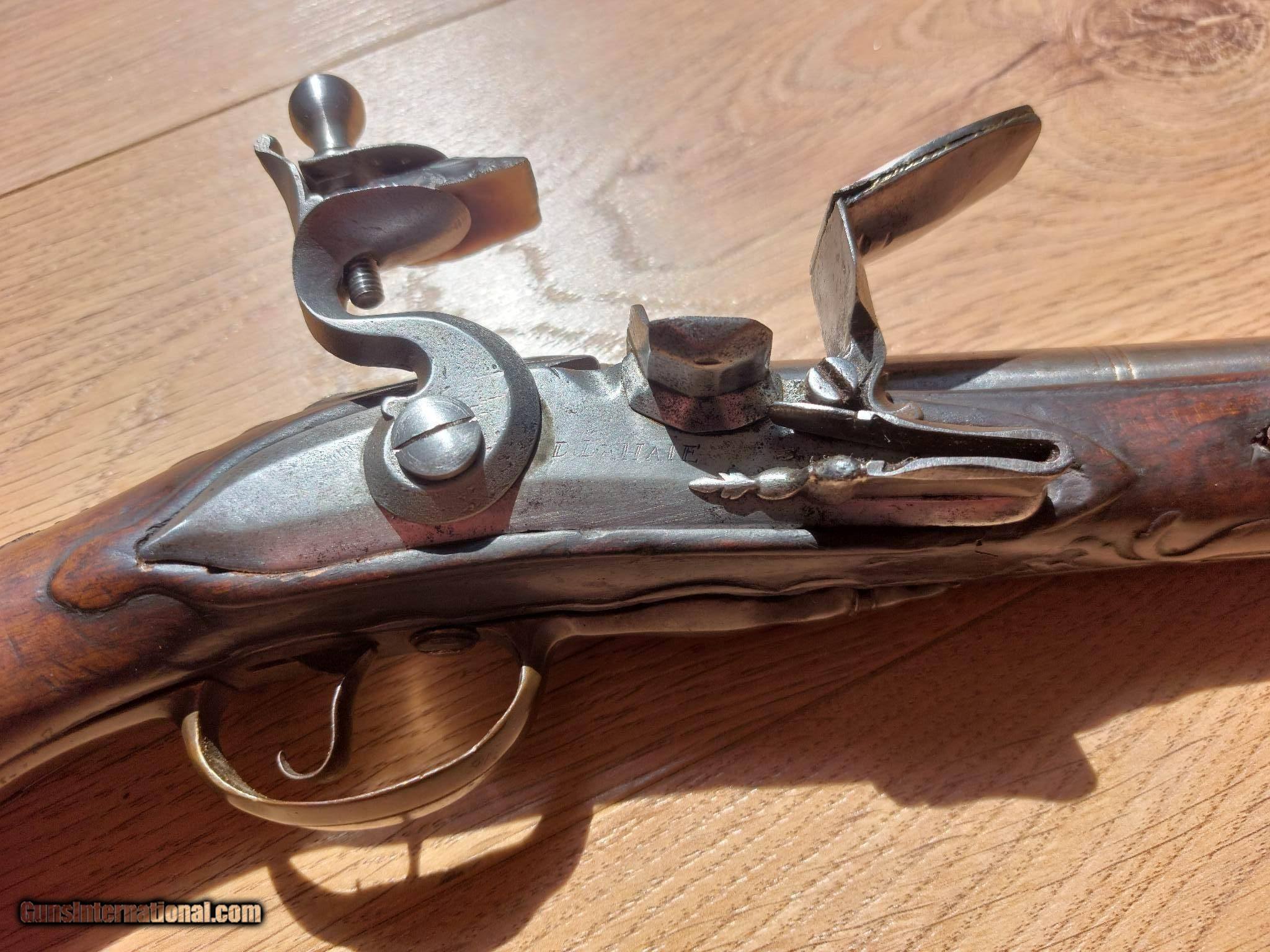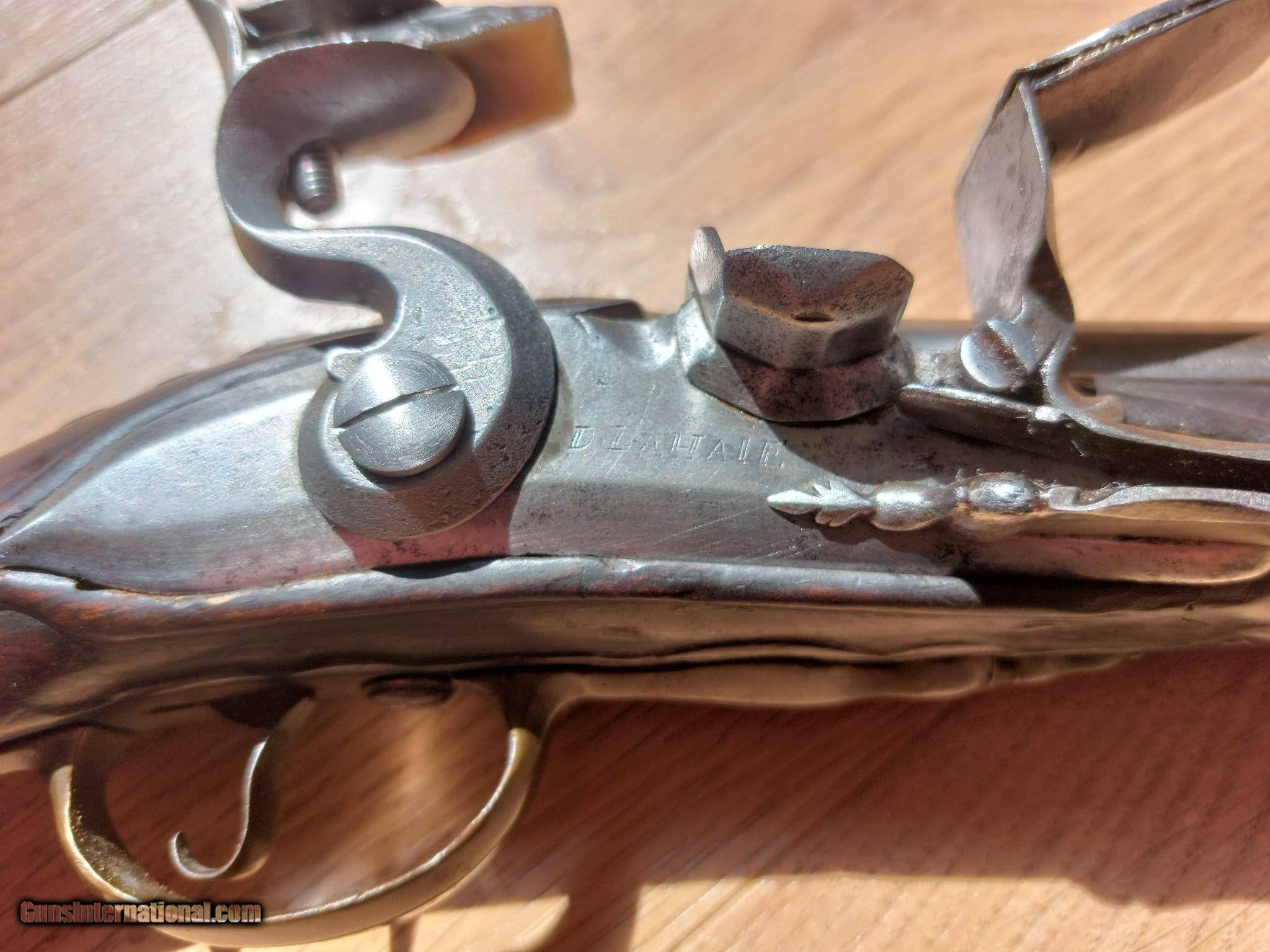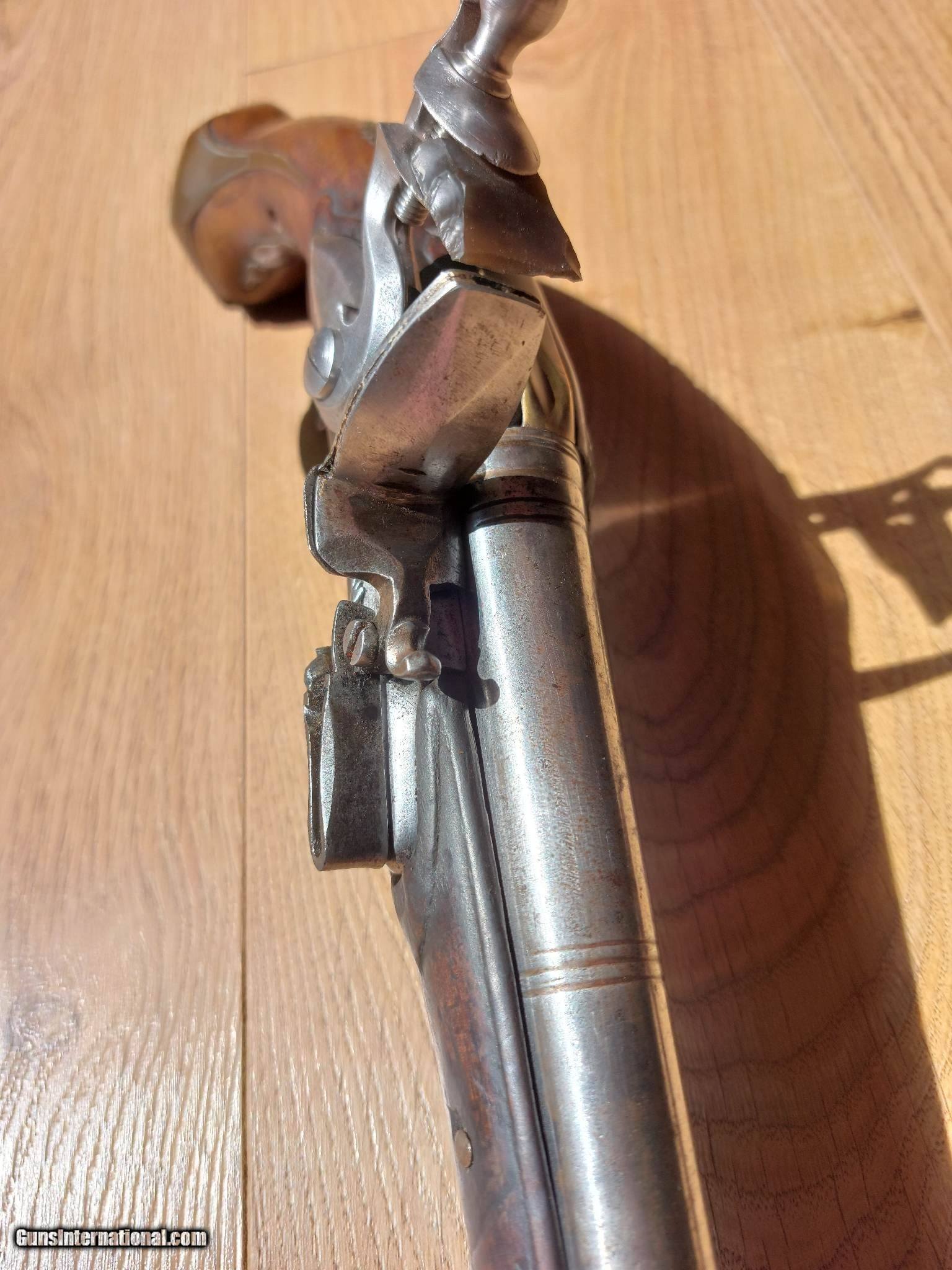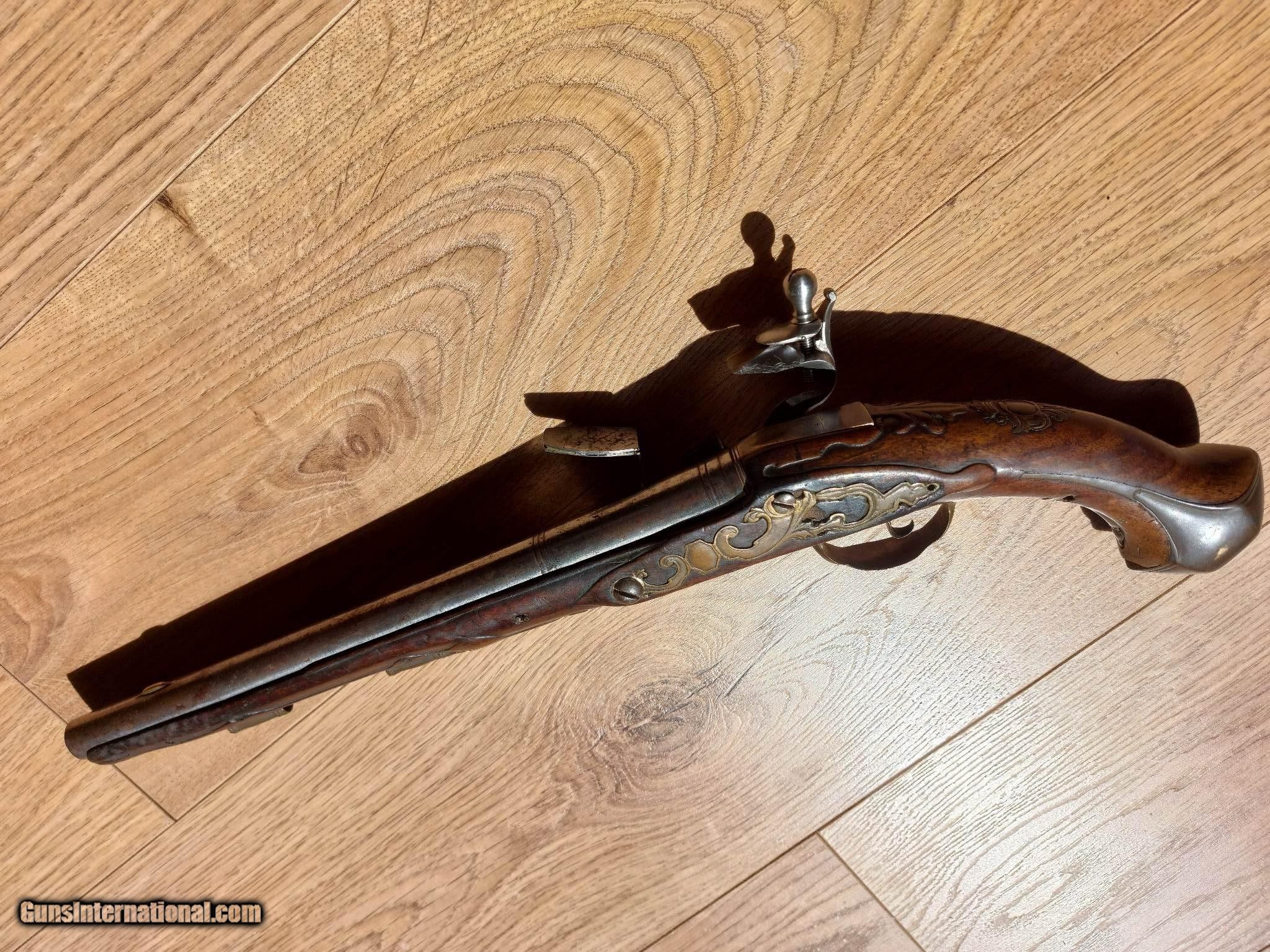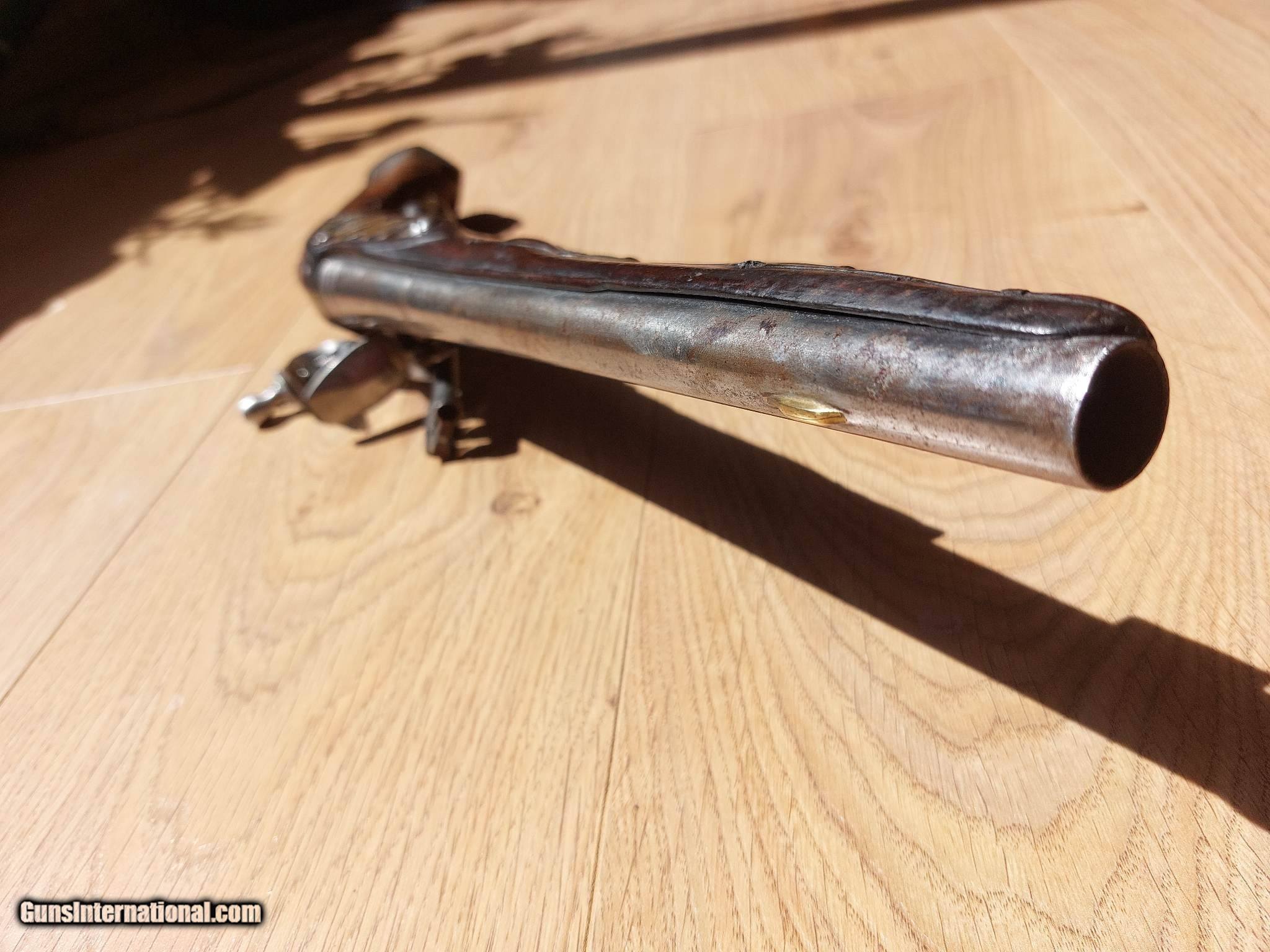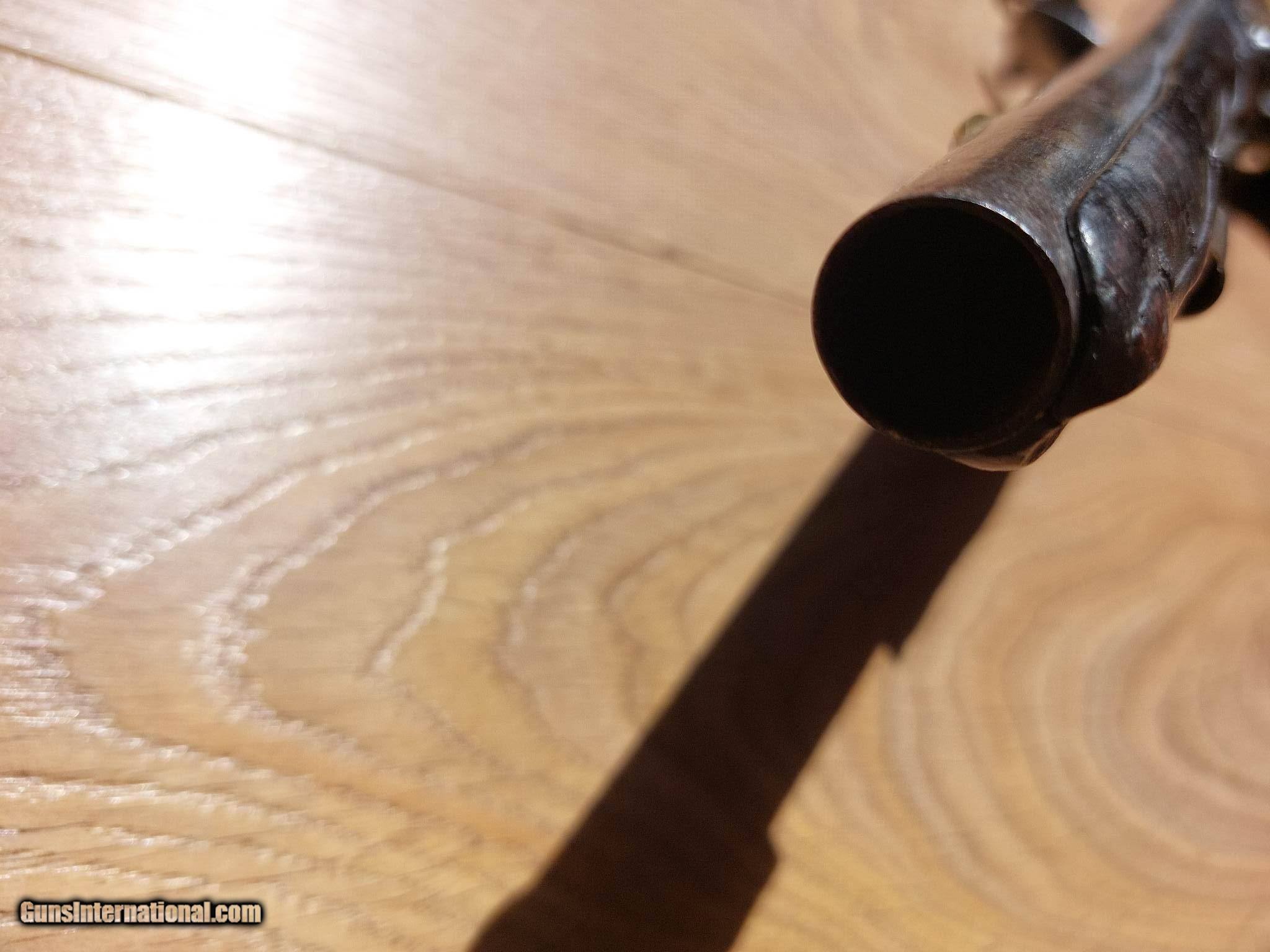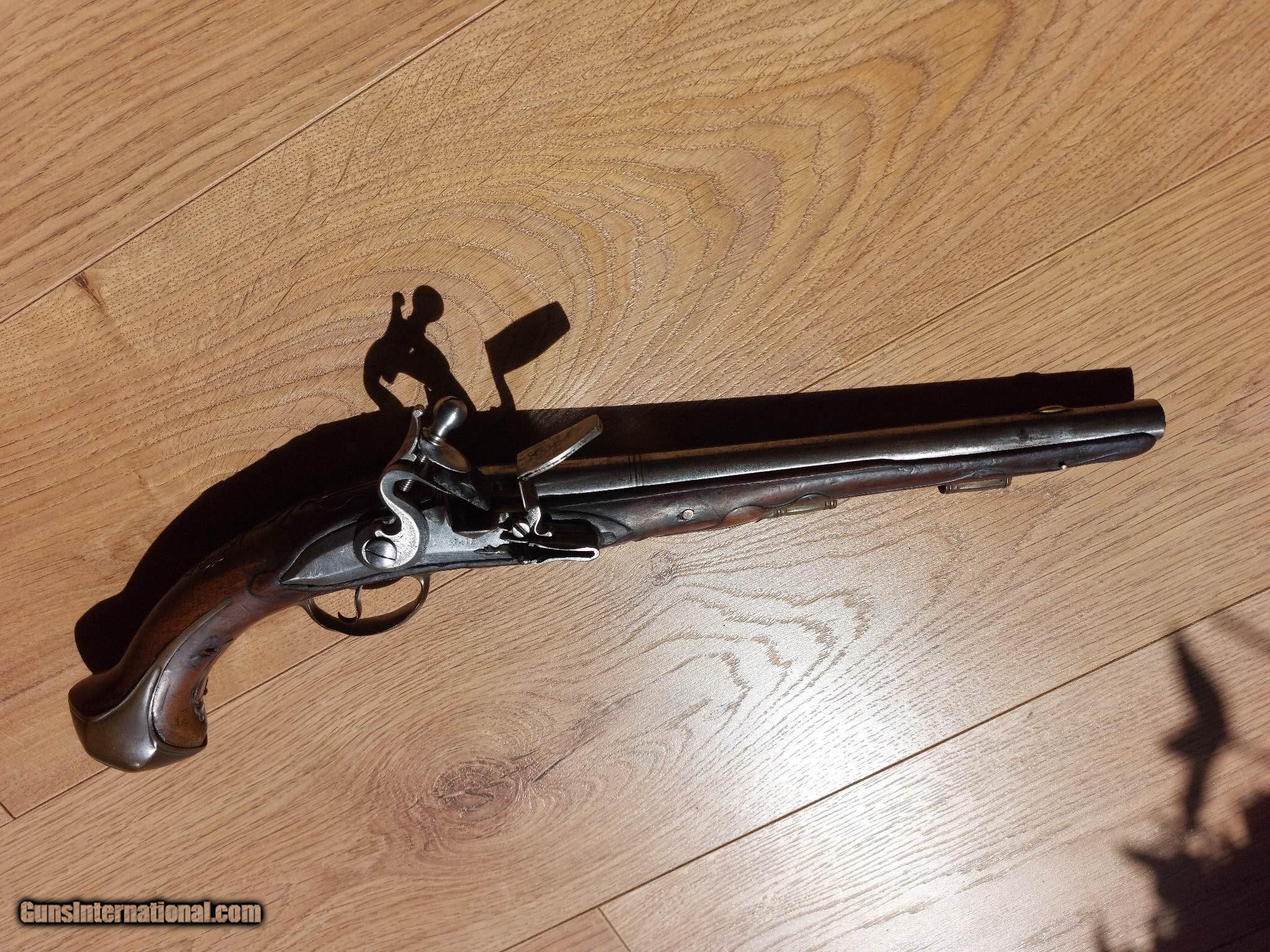Your Session is Ending
 The server has not detected any activity for the last 3 hours.
For your security, your session will expire in 2 minutes and you will be redirected to the Sign In page.
Would you like to stay signed in?
The server has not detected any activity for the last 3 hours.
For your security, your session will expire in 2 minutes and you will be redirected to the Sign In page.
Would you like to stay signed in?
18th century antique horse flintlock pistol Dutch Maastricht De la Haye
18th century antique horse flintlock pistol Dutch Maastricht De la Haye
Guns International #: 102314795
Category - Antique Pistols - Flintlock
- Antique Pistols - 1500-1850
Seller's Information
When emailing or calling sellers direct,
please mention that you saw their listing on GunsInternational.com
Seller: Marc-01
Company:
Company:
Member Since: 7/30/14
First Name: Marcus
Last Name: Toom
State:
Holland
Country: Netherlands
Active Listings: 0
Total Listings: 23
Seller Type: Private Seller
Return Policy: 3 day inspection and return policy on used guns and accessories.
Payment Methods:
18th century antique horse flintlock pistol Dutch Maastricht De la Haye
Description:
Wonderfull flintlock pistol, made by de La Haye in Maastrich in the Netherlands between 1730 and 50s.
19 1/2 " total length
12" in barrel with a 5/8 " bore
Flintlock throws a good spark and cocks in both first and second position.
Missing ramrod.
History of de La Haye:
François de la Haye. (Also called frans or françois) was born as franciscus servatius van den haeven, son of pierre de la haye. (Later the family will call themselves de la haye), from a family of gun makers. Occasionally he worked with his brother Michael. Rifle manufacturing is a thriving branch of craft and industry in what was then Maastricht. Maastricht gun makers enjoyed world fame in the 17th and 18th centuries, and Maastricht guns, especially the ivory decorative pistols, are highly sought after, and can still be admired in all major museums in Europe (except, of course, in Maastricht itself!). At the age of 32, françois de la haye buys a house in the sint-jorisstraat, which later turns out to bear the name "den Coninck van Denmarken", a name probably given by françois himself, because, among other things, he worked for Frederik iv , king of Denmark. He also has a house in the Boschstraat, called "den swaen", and a house on the Vrijthof, called "den dauphin". Franciscus was a very wealthy and influential gunmaker. He lived most of his life on the Vrijthof in a house called 'Dolphin'. and wherever he had his workshop. He produced namely between 1704 and 1750, later he buys a house in the Battery Street. In 1726 he is the most important gunsmith in Maastricht, François de la Haye, received an order for 120 snap haunce guns with bayonets. He stated to only use well dried walnut wood and the barrels will have to be tried 'with goet cruyt according to maestrichts gebruyck' (quality gunpowder as is the custom in Maastricht). In 1739 and in 1745 françois de la haye, together with his colleague Godefroy Corbeau, received two "million orders" from the states of holland : the first order concerns the delivery of a batch of 15,000 snap cocks with bayonets, to be delivered per 500 in the country's warehouse in delft. Our two maastricht rifle makers are in competition for this with the best rifle makers from other cities such as Utrecht and Names. The fact that they ultimately win the order shows that maastricht has the industrial capabilities to carry out such a large order. The two gun makers call in "suppliers" from the region for this. The manufacture of gun barrels is contracted out in Liège country (forêt en vaux-sous-olne), and the making of stocks from walnut wood is contracted out in Oirsbeek. The two partners receive a second "million dollar order" in 1745, this time for the delivery of 10,000 Snaplocks. The industrial workshop of François is his home on the west side of the Vrijthof, the current number 30. His studio is running at full speed, but causes so much nuisance to the neighborhood that people complain to the city council about it. In fact, horns are burned from time to time, which causes a penetrating and unbearable stench throughout the neighborhood and on the streets. The stench is so bad that on July 11, 1740, the city council decides to prohibit François de la Haye from continuing to burn horns, and asks him to carry out his work in a place that cannot give rise to complaints. François de la haye, of course, counter-argues that the burning of horns is necessary in the manufacturing process of guns, but then asks the council for permission to carry out his work in a house he has rented to the cumble, which the council grants. The burning of horns was used in the production process of the time to harden the surface of the iron. In doing so, the iron parts of the guns were laid in ashes of burnt horns. You can imagine that it smelled horribly. It was not the first time that françois de la haye got into a fight with the neighbors about the stench of burning horns.... François de la haye died at the age of 79. On January 29, 1753, he was buried in St Catherine's Church. Only a few signed copies of his production have survived. His son Angel Michael de la Haye then completed that job after his death and continued his father's business.
SOLD
Antique: Yes
Manufacturer: de La Haye
Condition: VG
Description:
Wonderfull flintlock pistol, made by de La Haye in Maastrich in the Netherlands between 1730 and 50s.
19 1/2 " total length
12" in barrel with a 5/8 " bore
Flintlock throws a good spark and cocks in both first and second position.
Missing ramrod.
History of de La Haye:
François de la Haye. (Also called frans or françois) was born as franciscus servatius van den haeven, son of pierre de la haye. (Later the family will call themselves de la haye), from a family of gun makers. Occasionally he worked with his brother Michael. Rifle manufacturing is a thriving branch of craft and industry in what was then Maastricht. Maastricht gun makers enjoyed world fame in the 17th and 18th centuries, and Maastricht guns, especially the ivory decorative pistols, are highly sought after, and can still be admired in all major museums in Europe (except, of course, in Maastricht itself!). At the age of 32, françois de la haye buys a house in the sint-jorisstraat, which later turns out to bear the name "den Coninck van Denmarken", a name probably given by françois himself, because, among other things, he worked for Frederik iv , king of Denmark. He also has a house in the Boschstraat, called "den swaen", and a house on the Vrijthof, called "den dauphin". Franciscus was a very wealthy and influential gunmaker. He lived most of his life on the Vrijthof in a house called 'Dolphin'. and wherever he had his workshop. He produced namely between 1704 and 1750, later he buys a house in the Battery Street. In 1726 he is the most important gunsmith in Maastricht, François de la Haye, received an order for 120 snap haunce guns with bayonets. He stated to only use well dried walnut wood and the barrels will have to be tried 'with goet cruyt according to maestrichts gebruyck' (quality gunpowder as is the custom in Maastricht). In 1739 and in 1745 françois de la haye, together with his colleague Godefroy Corbeau, received two "million orders" from the states of holland : the first order concerns the delivery of a batch of 15,000 snap cocks with bayonets, to be delivered per 500 in the country's warehouse in delft. Our two maastricht rifle makers are in competition for this with the best rifle makers from other cities such as Utrecht and Names. The fact that they ultimately win the order shows that maastricht has the industrial capabilities to carry out such a large order. The two gun makers call in "suppliers" from the region for this. The manufacture of gun barrels is contracted out in Liège country (forêt en vaux-sous-olne), and the making of stocks from walnut wood is contracted out in Oirsbeek. The two partners receive a second "million dollar order" in 1745, this time for the delivery of 10,000 Snaplocks. The industrial workshop of François is his home on the west side of the Vrijthof, the current number 30. His studio is running at full speed, but causes so much nuisance to the neighborhood that people complain to the city council about it. In fact, horns are burned from time to time, which causes a penetrating and unbearable stench throughout the neighborhood and on the streets. The stench is so bad that on July 11, 1740, the city council decides to prohibit François de la Haye from continuing to burn horns, and asks him to carry out his work in a place that cannot give rise to complaints. François de la haye, of course, counter-argues that the burning of horns is necessary in the manufacturing process of guns, but then asks the council for permission to carry out his work in a house he has rented to the cumble, which the council grants. The burning of horns was used in the production process of the time to harden the surface of the iron. In doing so, the iron parts of the guns were laid in ashes of burnt horns. You can imagine that it smelled horribly. It was not the first time that françois de la haye got into a fight with the neighbors about the stench of burning horns.... François de la haye died at the age of 79. On January 29, 1753, he was buried in St Catherine's Church. Only a few signed copies of his production have survived. His son Angel Michael de la Haye then completed that job after his death and continued his father's business.
SOLD
Antique: Yes
Manufacturer: de La Haye
Condition: VG
Click Photo to Enlarge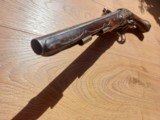

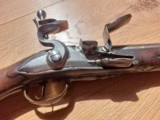
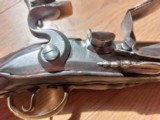
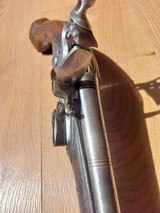
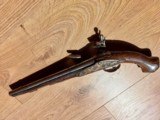
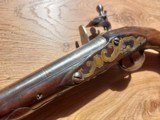
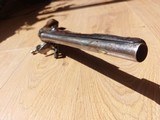
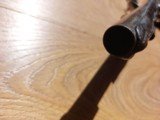
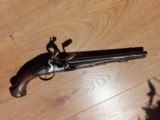
|
Guns International #: 102314795
Category - Antique Pistols - Flintlock
- Antique Pistols - 1500-1850
Seller's Information
When emailing or calling sellers direct,
please mention that you saw their listing on GunsInternational.com
Seller: Marc-01
Company: Member Since: 7/30/14
First Name: Marcus
Last Name: Toom
State:
Holland
Country: Netherlands
Active Listings: 0
Total Listings: 23
Seller Type: Private Seller
Return Policy: 3 day inspection and return policy on used guns and accessories.
Payment Methods:
18th century antique horse flintlock pistol Dutch Maastricht De la Haye
Description: Wonderfull flintlock pistol, made by de La Haye in Maastrich in the Netherlands between 1730 and 50s. 19 1/2 " total length 12" in barrel with a 5/8 " bore Flintlock throws a good spark and cocks in both first and second position. Missing ramrod. History of de La Haye: François de la Haye. (Also called frans or françois) was born as franciscus servatius van den haeven, son of pierre de la haye. (Later the family will call themselves de la haye), from a family of gun makers. Occasionally he worked with his brother Michael. Rifle manufacturing is a thriving branch of craft and industry in what was then Maastricht. Maastricht gun makers enjoyed world fame in the 17th and 18th centuries, and Maastricht guns, especially the ivory decorative pistols, are highly sought after, and can still be admired in all major museums in Europe (except, of course, in Maastricht itself!). At the age of 32, françois de la haye buys a house in the sint-jorisstraat, which later turns out to bear the name "den Coninck van Denmarken", a name probably given by françois himself, because, among other things, he worked for Frederik iv , king of Denmark. He also has a house in the Boschstraat, called "den swaen", and a house on the Vrijthof, called "den dauphin". Franciscus was a very wealthy and influential gunmaker. He lived most of his life on the Vrijthof in a house called 'Dolphin'. and wherever he had his workshop. He produced namely between 1704 and 1750, later he buys a house in the Battery Street. In 1726 he is the most important gunsmith in Maastricht, François de la Haye, received an order for 120 snap haunce guns with bayonets. He stated to only use well dried walnut wood and the barrels will have to be tried 'with goet cruyt according to maestrichts gebruyck' (quality gunpowder as is the custom in Maastricht). In 1739 and in 1745 françois de la haye, together with his colleague Godefroy Corbeau, received two "million orders" from the states of holland : the first order concerns the delivery of a batch of 15,000 snap cocks with bayonets, to be delivered per 500 in the country's warehouse in delft. Our two maastricht rifle makers are in competition for this with the best rifle makers from other cities such as Utrecht and Names. The fact that they ultimately win the order shows that maastricht has the industrial capabilities to carry out such a large order. The two gun makers call in "suppliers" from the region for this. The manufacture of gun barrels is contracted out in Liège country (forêt en vaux-sous-olne), and the making of stocks from walnut wood is contracted out in Oirsbeek. The two partners receive a second "million dollar order" in 1745, this time for the delivery of 10,000 Snaplocks. The industrial workshop of François is his home on the west side of the Vrijthof, the current number 30. His studio is running at full speed, but causes so much nuisance to the neighborhood that people complain to the city council about it. In fact, horns are burned from time to time, which causes a penetrating and unbearable stench throughout the neighborhood and on the streets. The stench is so bad that on July 11, 1740, the city council decides to prohibit François de la Haye from continuing to burn horns, and asks him to carry out his work in a place that cannot give rise to complaints. François de la haye, of course, counter-argues that the burning of horns is necessary in the manufacturing process of guns, but then asks the council for permission to carry out his work in a house he has rented to the cumble, which the council grants. The burning of horns was used in the production process of the time to harden the surface of the iron. In doing so, the iron parts of the guns were laid in ashes of burnt horns. You can imagine that it smelled horribly. It was not the first time that françois de la haye got into a fight with the neighbors about the stench of burning horns.... François de la haye died at the age of 79. On January 29, 1753, he was buried in St Catherine's Church. Only a few signed copies of his production have survived. His son Angel Michael de la Haye then completed that job after his death and continued his father's business. SOLD Antique: Yes Manufacturer: de La Haye Condition: VG |
Guns International #: 102314795
Category - Antique Pistols - Flintlock
- Antique Pistols - 1500-1850
Seller's Information
When emailing or calling sellers direct,
please mention that you saw their listing on GunsInternational.com
Seller: Marc-01
Company:
Company:
Member Since: 7/30/14
First Name: Marcus
Last Name: Toom
State:
Holland
Country: Netherlands
Active Listings: 0
Total Listings: 23
Seller Type: Private Seller
Return Policy: 3 day inspection and return policy on used guns and accessories.
Payment Methods:
18th century antique horse flintlock pistol Dutch Maastricht De la Haye
Description:
Wonderfull flintlock pistol, made by de La Haye in Maastrich in the Netherlands between 1730 and 50s.
19 1/2 " total length
12" in barrel with a 5/8 " bore
Flintlock throws a good spark and cocks in both first and second position.
Missing ramrod.
History of de La Haye:
François de la Haye. (Also called frans or françois) was born as franciscus servatius van den haeven, son of pierre de la haye. (Later the family will call themselves de la haye), from a family of gun makers. Occasionally he worked with his brother Michael. Rifle manufacturing is a thriving branch of craft and industry in what was then Maastricht. Maastricht gun makers enjoyed world fame in the 17th and 18th centuries, and Maastricht guns, especially the ivory decorative pistols, are highly sought after, and can still be admired in all major museums in Europe (except, of course, in Maastricht itself!). At the age of 32, françois de la haye buys a house in the sint-jorisstraat, which later turns out to bear the name "den Coninck van Denmarken", a name probably given by françois himself, because, among other things, he worked for Frederik iv , king of Denmark. He also has a house in the Boschstraat, called "den swaen", and a house on the Vrijthof, called "den dauphin". Franciscus was a very wealthy and influential gunmaker. He lived most of his life on the Vrijthof in a house called 'Dolphin'. and wherever he had his workshop. He produced namely between 1704 and 1750, later he buys a house in the Battery Street. In 1726 he is the most important gunsmith in Maastricht, François de la Haye, received an order for 120 snap haunce guns with bayonets. He stated to only use well dried walnut wood and the barrels will have to be tried 'with goet cruyt according to maestrichts gebruyck' (quality gunpowder as is the custom in Maastricht). In 1739 and in 1745 françois de la haye, together with his colleague Godefroy Corbeau, received two "million orders" from the states of holland : the first order concerns the delivery of a batch of 15,000 snap cocks with bayonets, to be delivered per 500 in the country's warehouse in delft. Our two maastricht rifle makers are in competition for this with the best rifle makers from other cities such as Utrecht and Names. The fact that they ultimately win the order shows that maastricht has the industrial capabilities to carry out such a large order. The two gun makers call in "suppliers" from the region for this. The manufacture of gun barrels is contracted out in Liège country (forêt en vaux-sous-olne), and the making of stocks from walnut wood is contracted out in Oirsbeek. The two partners receive a second "million dollar order" in 1745, this time for the delivery of 10,000 Snaplocks. The industrial workshop of François is his home on the west side of the Vrijthof, the current number 30. His studio is running at full speed, but causes so much nuisance to the neighborhood that people complain to the city council about it. In fact, horns are burned from time to time, which causes a penetrating and unbearable stench throughout the neighborhood and on the streets. The stench is so bad that on July 11, 1740, the city council decides to prohibit François de la Haye from continuing to burn horns, and asks him to carry out his work in a place that cannot give rise to complaints. François de la haye, of course, counter-argues that the burning of horns is necessary in the manufacturing process of guns, but then asks the council for permission to carry out his work in a house he has rented to the cumble, which the council grants. The burning of horns was used in the production process of the time to harden the surface of the iron. In doing so, the iron parts of the guns were laid in ashes of burnt horns. You can imagine that it smelled horribly. It was not the first time that françois de la haye got into a fight with the neighbors about the stench of burning horns.... François de la haye died at the age of 79. On January 29, 1753, he was buried in St Catherine's Church. Only a few signed copies of his production have survived. His son Angel Michael de la Haye then completed that job after his death and continued his father's business.
SOLD
Antique: Yes
Manufacturer: de La Haye
Condition: VG
Description:
Wonderfull flintlock pistol, made by de La Haye in Maastrich in the Netherlands between 1730 and 50s.
19 1/2 " total length
12" in barrel with a 5/8 " bore
Flintlock throws a good spark and cocks in both first and second position.
Missing ramrod.
History of de La Haye:
François de la Haye. (Also called frans or françois) was born as franciscus servatius van den haeven, son of pierre de la haye. (Later the family will call themselves de la haye), from a family of gun makers. Occasionally he worked with his brother Michael. Rifle manufacturing is a thriving branch of craft and industry in what was then Maastricht. Maastricht gun makers enjoyed world fame in the 17th and 18th centuries, and Maastricht guns, especially the ivory decorative pistols, are highly sought after, and can still be admired in all major museums in Europe (except, of course, in Maastricht itself!). At the age of 32, françois de la haye buys a house in the sint-jorisstraat, which later turns out to bear the name "den Coninck van Denmarken", a name probably given by françois himself, because, among other things, he worked for Frederik iv , king of Denmark. He also has a house in the Boschstraat, called "den swaen", and a house on the Vrijthof, called "den dauphin". Franciscus was a very wealthy and influential gunmaker. He lived most of his life on the Vrijthof in a house called 'Dolphin'. and wherever he had his workshop. He produced namely between 1704 and 1750, later he buys a house in the Battery Street. In 1726 he is the most important gunsmith in Maastricht, François de la Haye, received an order for 120 snap haunce guns with bayonets. He stated to only use well dried walnut wood and the barrels will have to be tried 'with goet cruyt according to maestrichts gebruyck' (quality gunpowder as is the custom in Maastricht). In 1739 and in 1745 françois de la haye, together with his colleague Godefroy Corbeau, received two "million orders" from the states of holland : the first order concerns the delivery of a batch of 15,000 snap cocks with bayonets, to be delivered per 500 in the country's warehouse in delft. Our two maastricht rifle makers are in competition for this with the best rifle makers from other cities such as Utrecht and Names. The fact that they ultimately win the order shows that maastricht has the industrial capabilities to carry out such a large order. The two gun makers call in "suppliers" from the region for this. The manufacture of gun barrels is contracted out in Liège country (forêt en vaux-sous-olne), and the making of stocks from walnut wood is contracted out in Oirsbeek. The two partners receive a second "million dollar order" in 1745, this time for the delivery of 10,000 Snaplocks. The industrial workshop of François is his home on the west side of the Vrijthof, the current number 30. His studio is running at full speed, but causes so much nuisance to the neighborhood that people complain to the city council about it. In fact, horns are burned from time to time, which causes a penetrating and unbearable stench throughout the neighborhood and on the streets. The stench is so bad that on July 11, 1740, the city council decides to prohibit François de la Haye from continuing to burn horns, and asks him to carry out his work in a place that cannot give rise to complaints. François de la haye, of course, counter-argues that the burning of horns is necessary in the manufacturing process of guns, but then asks the council for permission to carry out his work in a house he has rented to the cumble, which the council grants. The burning of horns was used in the production process of the time to harden the surface of the iron. In doing so, the iron parts of the guns were laid in ashes of burnt horns. You can imagine that it smelled horribly. It was not the first time that françois de la haye got into a fight with the neighbors about the stench of burning horns.... François de la haye died at the age of 79. On January 29, 1753, he was buried in St Catherine's Church. Only a few signed copies of his production have survived. His son Angel Michael de la Haye then completed that job after his death and continued his father's business.
SOLD
Antique: Yes
Manufacturer: de La Haye
Condition: VG
Guns International #: 102314795


Guns International #: 102314795
Category - Antique Pistols - Flintlock
- Antique Pistols - 1500-1850
Seller's Information
When emailing or calling sellers direct,
please mention that you saw their listing on GunsInternational.com
Seller: Marc-01
Company:
Company:
Member Since: 7/30/14
First Name: Marcus
Last Name: Toom
State:
Holland
Country: Netherlands
Active Listings: 0
Total Listings: 23
Seller Type: Private Seller
Return Policy: 3 day inspection and return policy on used guns and accessories.
Payment Methods:
18th century antique horse flintlock pistol Dutch Maastricht De la Haye
Description:
Wonderfull flintlock pistol, made by de La Haye in Maastrich in the Netherlands between 1730 and 50s.
19 1/2 " total length
12" in barrel with a 5/8 " bore
Flintlock throws a good spark and cocks in both first and second position.
Missing ramrod.
History of de La Haye:
François de la Haye. (Also called frans or françois) was born as franciscus servatius van den haeven, son of pierre de la haye. (Later the family will call themselves de la haye), from a family of gun makers. Occasionally he worked with his brother Michael. Rifle manufacturing is a thriving branch of craft and industry in what was then Maastricht. Maastricht gun makers enjoyed world fame in the 17th and 18th centuries, and Maastricht guns, especially the ivory decorative pistols, are highly sought after, and can still be admired in all major museums in Europe (except, of course, in Maastricht itself!). At the age of 32, françois de la haye buys a house in the sint-jorisstraat, which later turns out to bear the name "den Coninck van Denmarken", a name probably given by françois himself, because, among other things, he worked for Frederik iv , king of Denmark. He also has a house in the Boschstraat, called "den swaen", and a house on the Vrijthof, called "den dauphin". Franciscus was a very wealthy and influential gunmaker. He lived most of his life on the Vrijthof in a house called 'Dolphin'. and wherever he had his workshop. He produced namely between 1704 and 1750, later he buys a house in the Battery Street. In 1726 he is the most important gunsmith in Maastricht, François de la Haye, received an order for 120 snap haunce guns with bayonets. He stated to only use well dried walnut wood and the barrels will have to be tried 'with goet cruyt according to maestrichts gebruyck' (quality gunpowder as is the custom in Maastricht). In 1739 and in 1745 françois de la haye, together with his colleague Godefroy Corbeau, received two "million orders" from the states of holland : the first order concerns the delivery of a batch of 15,000 snap cocks with bayonets, to be delivered per 500 in the country's warehouse in delft. Our two maastricht rifle makers are in competition for this with the best rifle makers from other cities such as Utrecht and Names. The fact that they ultimately win the order shows that maastricht has the industrial capabilities to carry out such a large order. The two gun makers call in "suppliers" from the region for this. The manufacture of gun barrels is contracted out in Liège country (forêt en vaux-sous-olne), and the making of stocks from walnut wood is contracted out in Oirsbeek. The two partners receive a second "million dollar order" in 1745, this time for the delivery of 10,000 Snaplocks. The industrial workshop of François is his home on the west side of the Vrijthof, the current number 30. His studio is running at full speed, but causes so much nuisance to the neighborhood that people complain to the city council about it. In fact, horns are burned from time to time, which causes a penetrating and unbearable stench throughout the neighborhood and on the streets. The stench is so bad that on July 11, 1740, the city council decides to prohibit François de la Haye from continuing to burn horns, and asks him to carry out his work in a place that cannot give rise to complaints. François de la haye, of course, counter-argues that the burning of horns is necessary in the manufacturing process of guns, but then asks the council for permission to carry out his work in a house he has rented to the cumble, which the council grants. The burning of horns was used in the production process of the time to harden the surface of the iron. In doing so, the iron parts of the guns were laid in ashes of burnt horns. You can imagine that it smelled horribly. It was not the first time that françois de la haye got into a fight with the neighbors about the stench of burning horns.... François de la haye died at the age of 79. On January 29, 1753, he was buried in St Catherine's Church. Only a few signed copies of his production have survived. His son Angel Michael de la Haye then completed that job after his death and continued his father's business.
SOLD
Antique: Yes
Manufacturer: de La Haye
Condition: VG
Description:
Wonderfull flintlock pistol, made by de La Haye in Maastrich in the Netherlands between 1730 and 50s.
19 1/2 " total length
12" in barrel with a 5/8 " bore
Flintlock throws a good spark and cocks in both first and second position.
Missing ramrod.
History of de La Haye:
François de la Haye. (Also called frans or françois) was born as franciscus servatius van den haeven, son of pierre de la haye. (Later the family will call themselves de la haye), from a family of gun makers. Occasionally he worked with his brother Michael. Rifle manufacturing is a thriving branch of craft and industry in what was then Maastricht. Maastricht gun makers enjoyed world fame in the 17th and 18th centuries, and Maastricht guns, especially the ivory decorative pistols, are highly sought after, and can still be admired in all major museums in Europe (except, of course, in Maastricht itself!). At the age of 32, françois de la haye buys a house in the sint-jorisstraat, which later turns out to bear the name "den Coninck van Denmarken", a name probably given by françois himself, because, among other things, he worked for Frederik iv , king of Denmark. He also has a house in the Boschstraat, called "den swaen", and a house on the Vrijthof, called "den dauphin". Franciscus was a very wealthy and influential gunmaker. He lived most of his life on the Vrijthof in a house called 'Dolphin'. and wherever he had his workshop. He produced namely between 1704 and 1750, later he buys a house in the Battery Street. In 1726 he is the most important gunsmith in Maastricht, François de la Haye, received an order for 120 snap haunce guns with bayonets. He stated to only use well dried walnut wood and the barrels will have to be tried 'with goet cruyt according to maestrichts gebruyck' (quality gunpowder as is the custom in Maastricht). In 1739 and in 1745 françois de la haye, together with his colleague Godefroy Corbeau, received two "million orders" from the states of holland : the first order concerns the delivery of a batch of 15,000 snap cocks with bayonets, to be delivered per 500 in the country's warehouse in delft. Our two maastricht rifle makers are in competition for this with the best rifle makers from other cities such as Utrecht and Names. The fact that they ultimately win the order shows that maastricht has the industrial capabilities to carry out such a large order. The two gun makers call in "suppliers" from the region for this. The manufacture of gun barrels is contracted out in Liège country (forêt en vaux-sous-olne), and the making of stocks from walnut wood is contracted out in Oirsbeek. The two partners receive a second "million dollar order" in 1745, this time for the delivery of 10,000 Snaplocks. The industrial workshop of François is his home on the west side of the Vrijthof, the current number 30. His studio is running at full speed, but causes so much nuisance to the neighborhood that people complain to the city council about it. In fact, horns are burned from time to time, which causes a penetrating and unbearable stench throughout the neighborhood and on the streets. The stench is so bad that on July 11, 1740, the city council decides to prohibit François de la Haye from continuing to burn horns, and asks him to carry out his work in a place that cannot give rise to complaints. François de la haye, of course, counter-argues that the burning of horns is necessary in the manufacturing process of guns, but then asks the council for permission to carry out his work in a house he has rented to the cumble, which the council grants. The burning of horns was used in the production process of the time to harden the surface of the iron. In doing so, the iron parts of the guns were laid in ashes of burnt horns. You can imagine that it smelled horribly. It was not the first time that françois de la haye got into a fight with the neighbors about the stench of burning horns.... François de la haye died at the age of 79. On January 29, 1753, he was buried in St Catherine's Church. Only a few signed copies of his production have survived. His son Angel Michael de la Haye then completed that job after his death and continued his father's business.
SOLD
Antique: Yes
Manufacturer: de La Haye
Condition: VG
Guns International Advertising Policy
GunsInternational.com is the #1 Gun Classified website that brings gun buyers and gun brokers or sellers together through classifed advertising of guns, gun related items and services for sale online. If you are looking to buy guns or sell guns, you have come to the right place. GunsInternational.com gun classifieds currently have over 200,000 guns for sale online by numerous dealers and collectors alike. Guns International makes no representation or warranty as to the accuracy of the information contained in the gun classifieds, gun parts or gun services classifieds listings. Buyers and sellers are required to know and comply with all applicable local, state, federal and international firearm laws.
GunsInternational.com is the #1 Gun Classified website that brings gun buyers and gun brokers or sellers together through classifed advertising of guns, gun related items and services for sale online. If you are looking to buy guns or sell guns, you have come to the right place. GunsInternational.com gun classifieds currently have over 200,000 guns for sale online by numerous dealers and collectors alike. Guns International makes no representation or warranty as to the accuracy of the information contained in the gun classifieds, gun parts or gun services classifieds listings. Buyers and sellers are required to know and comply with all applicable local, state, federal and international firearm laws.
Listings
Home
New Today
New This Week
Rifles For Sale Online
Shotguns For Sale Online
Handguns For Sale Online
Pistols For Sale Online
Revolvers For Sale Online
NFA
Gun Parts For Sale Online
Services
Home
New Today
New This Week
Rifles For Sale Online
Shotguns For Sale Online
Handguns For Sale Online
Pistols For Sale Online
Revolvers For Sale Online
NFA
Gun Parts For Sale Online
Services
©2006 - 2025 all rights reserved. | Guns International.com | V4.1 ww3



Privacy Policy
User Agreement
FAQs
Contact Us
©2006 - 2025 all rights reserved.
Guns International.com | V4.1 ww3
Guns International.com | V4.1 ww3

